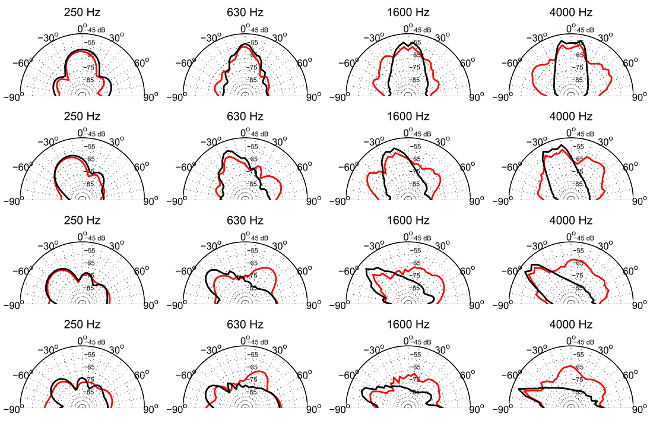- Details
- Published: 09 January 2013
Diffusers are structures that have been specifically designed to scatter sound energy. They are used for example on back walls in large auditoria for preventing disturbing echoes and for reducing coloration due to standing waves in small sound reproduction rooms. There are a variety of different design principles for diffusers (number theoretic/Schroeder diffusers, optimized curved surfaces, fractals etc.), but generally all of them aim at fulfilling the same criterion: an ideal diffuser produces within its operational bandwidth a polar response that is invariant to the angle of incidence, angle of observation and frequency [1].
The diffusion coefficient [2] quantifies the degree of uniformity of the polar response of a surface and it has been developed to serve as a quality measure for diffusers. It is also useful for quantifying the diffusing properties of other surfaces, for example the layered wall structures found in some concert halls. These structures feature a panel with some form of openings or perforations and a back wall behind the panel. Typically structures of such description are known as Helmholtz absorbers or distributed Helmholtz resonators [3], that work on the principle of mass-spring resonance and absorptive material inside the cavity. However, when the area of the openings is greater and no absorptive material is present, the structures behave differently. These kind of structures are found in many concert halls, including the Helsinki Music Centre concert hall built in 2011, yet the principles of their design, application and effects are somewhat elusive.
Research on effects of layered wall structures
In our work, we have done 2-D FDTD simulations in order to examine the reflections from layered wall structures. These studies include the time- and frequency-domain effects and spatial diffusion [4][5]. The slatted panel is frequency-selective in reflecting and transmitting sound; low frequencies are mostly transmitted through and high frequencies are reflected. Additionally, the panel introduces a notch in the frequency response. Wider slats and thicker panel lower the notch frequency.
The panel coupled with a flat back wall creates a resonant system where the panel acts as a filter, and the cavity acts as a delay line. The overall reflected sound consists of multiple successive wavefronts, generated by the combination of delays imposed by the cavity depth, and the accumulated filtering by multiple interactions with the panel. In the frequency domain, this is a comb filter effect, due to the interference between the differently delayed wavefronts. The saw corrugated back wall makes the situation more complex, but the most prominent aspect of it is the added diffusion at wavelengths comparable to the dimensions of the corrugation.
References
[1] T.J. Cox and P. D'Antonio. Acoustic Absorbers and Diffusers: theory, design and application. Taylor & Francis, second edition, 2009.
[2] AES-4id-2001. AES information document for room acoustics and sound reinforcement systems – characterization and measurement of surface scattering uniformity. JAES, 49:149-165, 2001.
[3] T. E. Vigran. Building Acoustics. Taylor & Francis, first edition, 2008.
[5] A. Haapaniemi, A. Southern, T. Lokki. A finite-difference time-domain investigation of reflections from layered wall structures. ISRA 2013.





